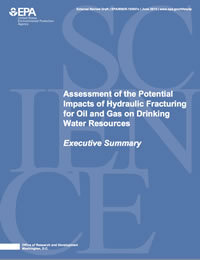Assessment of the Potential Impacts of Hydraulic Fracturing for Oil and Gas on Drinking Water Resources

EPA
‘Assessment of the Potential Impacts of Hydraulic Fracturing for Oil and Gas on Drinking Water Resources’
4 juni 2015, 25 pagina’s
Summary
Draft assessment on the potential impacts of hydraulic fracturing activities on drinking water resources in the United States. The assessment, done at the request of Congress, shows that while hydraulic fracturing activities in the U.S. are carried out in a way that have not led to widespread, systemic impacts on drinking water resources, there are potential vulnerabilities in the water lifecycle that could impact drinking water. The assessment follows the water used for hydraulic fracturing from water acquisition, chemical mixing at the well pad site, well injection of fracking fluids, the collection of hydraulic fracturing wastewater (including flowback and produced water), and wastewater treatment and disposal .
Conclusions
‘Through this national-level assessment, we have identified potential mechanisms by which hydraulic fracturing could affect drinking water resources. Above ground mechanisms can affect surface and ground water resources and include water withdrawals at times or in locations of low water availability, spills of hydraulic fracturing fluid and chemicals or produced water, and inadequate treatment and discharge of hydraulic fracturing wastewater. Below ground mechanisms include movement of liquids and gases via the production well into underground drinking water resources and movement of liquids and gases from the fracture zone to these resources via pathways in subsurface rock formations.
We did not find evidence that these mechanisms have led to widespread, systemic impacts on drinking water resources in the United States. Of the potential mechanisms identified in this report, we found specific instances where one or more of these mechanisms led to impacts on drinking water resources, including contamination of drinking water wells. The cases occurred during both routine activities and accidents and have resulted in impacts to surface or ground water. Spills of hydraulic fracturing fluid and produced water in certain cases have reached drinking water resources, both surface and ground water. Discharge of treated hydraulic fracturing wastewater has increased contaminant concentrations in receiving surface waters. Below ground movement of fluids, including gas, most likely via the production well, have contaminated drinking water resources. In some cases, hydraulic fracturing fluids have also been directly injected into drinking water resources, as defined in this assessment, to produce oil or gas that co-exists in those formations.
Meer informatie
EPA-website, 4 juni 2015: EPA’s Study of Hydraulic Fracturing for Oil and Gas and Its Potential Impact on Drinking Water Resources



